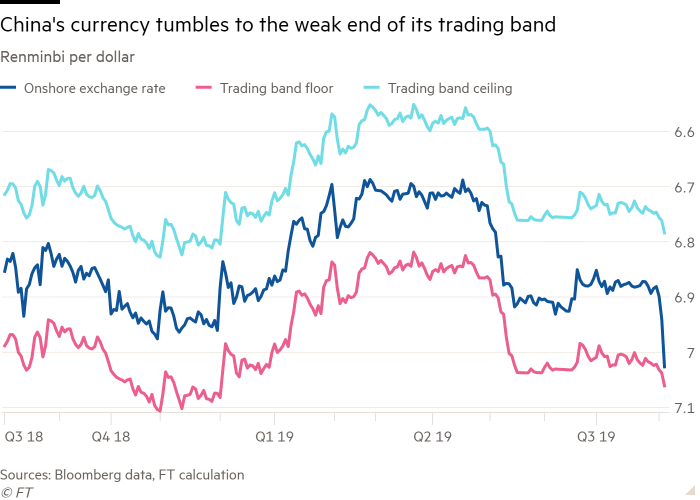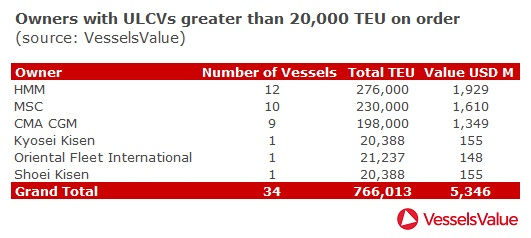Global markets dip after renminbi hits weakest level in 11 years
- Fasttranz

- Aug 5, 2019
- 4 min read
China’s central bank blames tariffs for move as Trump hits out at ‘major violation’
The renminbi lingered at its weakest level since the 2008 global financial crisis on Monday, triggering an angry response from US president Donald Trump and causing a wave of jitters across global markets.
The renminbi is permitted to trade 2 per cent on either side of a daily midpoint set by the People's Bank of China.
The onshore exchange rate fell past Rmb7 per US dollar on Monday for the first time since May 2008, dropping more than 1.6 per cent by the end of European trading hours to trade at Rmb7.05 per dollar, as prospects of a trade deal between Beijing and Washington faded.
The midpoint set by the PBoC on Monday of Rmb6.9225 was the lowest since December, when trade tensions were last at fever pitch.
In response, Mr Trump accused China of manipulating its currency. “China dropped the price of their currency to an almost a historic low,” he tweeted. “It’s called “currency manipulation.” Are you listening Federal Reserve? This is a major violation which will greatly weaken China over time!”
In a statement, the PBoC blamed trade protectionism and tariffs on Chinese goods for the currency’s weakening, without specifically mentioning the US, but added that it “has the experience, confidence and capacity to keep the renminbi exchange rate fundamentally stable at a reasonable and balanced level”.
On Monday evening in Beijing Yi Gang, governor of the People’s Bank of China, said in a statement China would not to use the renminbi to cope with “external disturbances” such as trade tensions.
“China acts as a responsible major country, will abide by the spirit of the G20 leaders’ summit on exchange rate issues, adhere to a market-determined exchange rate system, will not engage in competitive devaluation and will not use the [renminbi] exchange rate for competitive purposes,” Mr Yi said.
Year to date, the onshore rate has weakened by 2.7 per cent against the dollar. The offshore renminbi, the version of the currency which international investors can access outside of China, has slumped some 1.7 per cent to its weakest ever rate since its inception in 2010, trading at Rmb7.0940 per dollar at the end of European market hours.
The renminbi’s decline ricocheted across global financial markets, sending stocks and emerging market currencies sinking and adding fuel to an intense rally in government bonds.
US equities tumbled at the open, with the S&P 500 down 1.9 per cent in early trade, putting the equities benchmark on track for its biggest one-day drop since May 13 and a sixth consecutive day of declines. It also set the index up for its longest losing streak in 10 months.
The Dow Jones Industrial Average dropped 1.9 per cent and the Nasdaq Composite fell 2.5 per cent. The Cboe’s Vix, a measure of volatility nicknamed Wall Street’s “fear gauge” jumped above 21 points for the first time since mid-May.
Britain’s FTSE 100 fell 2.2 per cent, France’s CAC 40 lost 2 per cent and Germany’s Dax declined 1.6 per cent. MSCI’s broad index of Asian stocks outside Japan fell 2.5 per cent, with Japan’s Topix sliding 1.8 per cent.
The yen, seen as a safe haven in uncertain times, strengthened beyond the ¥106 mark against the dollar to trade up 0.6 per cent at ¥105.99, taking it to its strongest level since early 2018. In European hours the dollar was able to regain some ground and recover to trade at ¥106.12.
Christy Tan, head of Asia markets strategy and research at NAB, said the move to let the renminbi weaken past Rmb7 “could be deemed as part of the response to the new tariffs” from Mr Trump.
She said the renminbi was not Beijing’s preferred tool for coping with the trade war, but “China has definitely run out of goods to impose tariffs on in response to the US . . . and the currency has become one of the policy options”.
“The market implications of breaching 7.0 are tremendous,” said Hao Zhou, economist at Commerzbank. “We will see a new wave of depreciation among Asian currencies in the foreseeable future, and there could be further risk-off movements in the global markets. It looks like a tsunami is coming.”
“Cracking seven”, in currency trader talk, is seen as a breach of a psychologically important threshold for the renminbi among ordinary Chinese, who have not seen their currency weaken to the current levels since 2008.
In its defence of the Rmb7 floor, the PBoC in 2016 was forced to burn through much of its foreign exchange reserves, spending as much as $107bn in a single month, after its shock devaluation of the renminbi in August the previous year that marked the currency’s biggest one-day drop in decades.
The 2015 devaluation, while a short-term boost for the Chinese economy, prompted major capital outflows and drew the ire of critics in Washington, who accused Beijing of currency manipulation and ensured regular scrutiny from the US Treasury Department.
NAB’s Ms Tan said that although the PBoC had allowed the Rmb7 floor to give way, the central bank would step in to prevent capital outflows from increasing if necessary.
“Allowing the currency to depreciate in an orderly and gradual manner — that will be allowed, but speculative activities would not be tolerated,” she said.







Comments